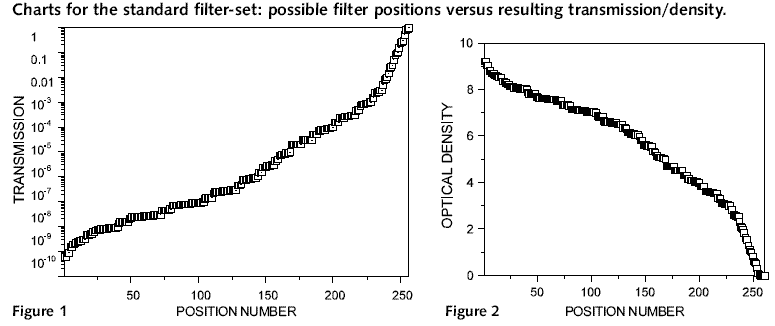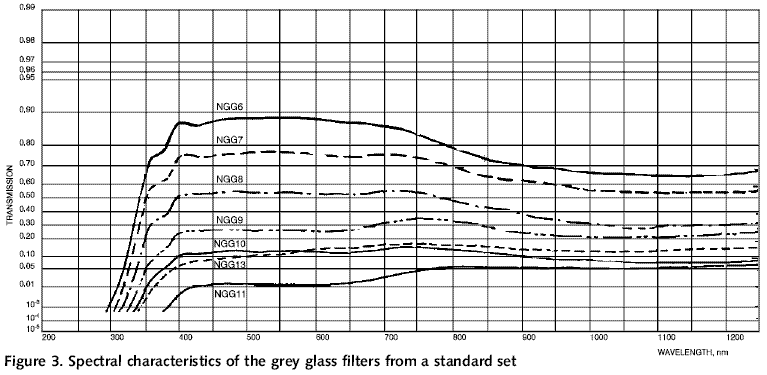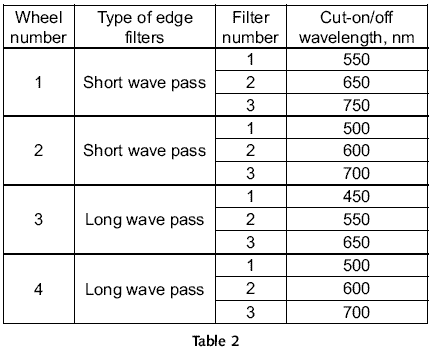Some applications of optical filters
- In systems for laser beam diagnostics with CCD-cameras.
- Measurement of laser power, pulse energy and pulse duration.
- Spectroscopy.
- We can offer a set of bandpass filters for mercury lamp, laser lines, and for other your needs.
A choice of filters is available for our standard 4-
wheel attenuators, allowing 256 relative positions
of wheels, rendering 99 different transmission values,
of which you can find a very close match to
the desired value. Discrete filters permit to establish
accurate optical density.
Also we can offer designs with 1, 2, 3 and more
wheels.
Variable wheel attenuators come with a standard,
most popular, set of filters listed in table
standard filters are made of neutral grey glass
spectral characteristics according to figure
Alternatively, attenuators (wheels and
could be manufactured to individual orders.
could supply variable wheel attenuators
filters, which you can fit by yourself.



In most cases the detectors (CCDs, photodiodes,
photomultipliers, etc.), which are used for diagnostics
of laser radiations, are too delicate for the direct
measurement of high powers, such as from ion
lasers or pulsed solid-state lasers. An attenuator
may be required to reduce laser power density at
the surface of detector. Optical attenuators must be
used when the laser output-power or power density
exceeds the working (linear) range or the damage
threshold of the detector. (Draft International
Standard ISO/TC172/SC 9/WG1)
For example, the damage threshold for a typical
commercially available CCD is about 100 mW/cm?,
for the ultra high speed photodetectors series AR-S
(Antel Optronic Inc.) it is about 200 mW/cm?. On
the other hand, laser power must be adjusted to
the optimum point, which is typically just below
the saturation level of the detector. For example, a
typical commercially available CCD saturates at only
10WA168-02
According to your request we may
design an attenuator with any number
of wheels.
10CWA168 with a CCD camera
Close Variable Wheel Attenuator 10CWA168
is ideally suited for use with CCD cameras.
Adapters 10R168 and 10A168 are used for connection.
0.05 mW/cm? at 632.8 nm and at 5.5mW/cm? at
1.06 mm (see R. Rypma “Dimming the Light ...”, in
Photonics Spectra N.10, 1995, p.145).
For preliminary attenuation of very high power
lasers the simplest approach is to use just the first
surface reflection of an uncoated laser-grade substrate.
It is useful to have an intensity adjustment range
of at least 1000:1 or more in this final stage. Even
when working with a single-wavelength laser, operated
at one power level, this range may be encountered
when making measurements at different
points in the optical train.
After major reduction in intensity by reflection
off an uncoated substrate is achieved, some of the
low-power neutral density filters of the high optical
quality can bring the beam power to the exact
level necessary for optimum measurement by detection
system.
Set of wheel edge filters for 10WA168EF
Set of wheel edge filters is used when it
is necessary to reject the shorter or the
longer wavelengths.
Also, a combination of short and long
wavelength filters allows to construct band
pass filters with variable bandwidth (for
fluorescence analysis, etc.)
As standard 10WA168EF of 4 wheels
comes with 6 long-wave pass filters and 6
short-wave pass filters. One hole in each
wheel is left open.
Long-wave pass filters are made of absorbing
color glass.
Shortwave pass filters are interference
filters.
